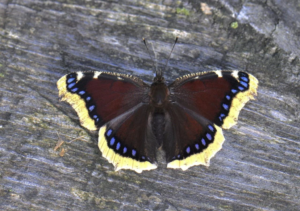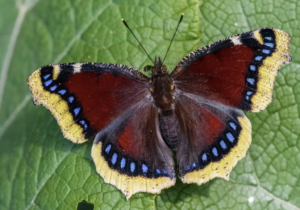
You always know where to find me, right? within my yard. I’m a huge gardener. Seeing your hard work come to fruition and witnessing the growth of plants is a deeply satisfying experience. However, let’s face it—it can be very difficult. Taking care of bugs is one of the main obstacles. Sometimes you’re not even sure which pests are good for you and which ones would ruin all of your hard-earned possessions.
I just saw a picture floating around social media that encapsulates this uncertainty. It scared me when I first saw it. The image displayed a leaf covered in extremely little, very detailed black geometric patterns. Initially, it appeared as though the leaf was encased in an extraterrestrial lattice or perhaps some strange illness. Like myself, a lot of others were curious as to what it might be.

I looked into it and found that these odd patterns are actually the eggs of Nymphalis Antiopa butterflies. Allow me to introduce you to this species if you are unfamiliar with it. The Mourning Cloak butterfly, Nymphalis Antiopa, is an intriguing insect with an unusual life cycle and some intriguing characteristics.
Let’s start by discussing the eggs. These eggs on a leaf were seen in close-up in the picture I saw. They resemble a thin layer of fine black lace that has been applied to the surface. After you get over your initial shock, it’s actually rather lovely. Clusters of eggs are laid, and each small egg is a marvel of flawless geometry. “This is either going to be really good for my garden or really bad,” was my initial thinking upon seeing it.
Fortunately, there is good news: the Nymphalis Antiopa butterfly has several uses. Although the caterpillars, or larvae, eat leaves, they usually have a preference for willows, elms, and poplars among other trees and shrubs. Therefore, you should be safe if you have a garden that is full of veggies and flowers. Since these butterflies also feed on decaying fruit and aid in the process of decomposition, they can really be quite beneficial.

It’s interesting to watch these butterflies go through their entire cycle. The caterpillars emerge from those weird, complicated eggs once they hatch. Their bodies are bristly and spiky, and they are black with tiny white dots. They go through a series of phases called instars, during which they grow larger and lose their skin.
When they reach adulthood, the caterpillars locate a secure location to pupate. They convert themselves within a chrysalis, which resembles a tiny sleeping bag. Depending on the environment and time of year, this stage may extend for a few weeks or several months. When they do emerge, they are stunning Mourning Cloak butterflies, with dark, velvety wings speckled with blue and surrounded by a bright yellow edging.
The behavior of Mourning Cloak butterflies is among their most fascinating characteristics. These butterflies hibernate in the winter, in contrast to many other species. They locate a comfortable hiding place under an old shed, beneath loose bark, or even in a pile of wood. They are among the first butterflies to appear in the spring, frequently even before the flowers begin to open. They get their name “Mourning Cloaks” in part because of their early arrival; the stark, early spring scenery contrasts with their dark, melancholy wings, which resemble a mourning garment.

As gardeners, we frequently concentrate on how insects affect our plants right away. When we see caterpillars, we fear that they will devour everything. However, it’s critical to stand back and consider the wider picture. The Nymphalis Antiopa butterfly is an excellent illustration of how nature maintains equilibrium. Although the caterpillars will consume some leaves, your garden won’t be completely destroyed by them. In actuality, you’re improving the ecosystem by giving these butterflies a place to live.
What should you do, then, if you discover these caterpillars or eggs in your garden? I would suggest letting them alone. Take pleasure in the procedure and observe the change. You can carefully relocate the caterpillars to a tree or shrub where they will be content and less likely to eat your priceless blossoms if you’re extremely concerned about your plants.

The key to gardening is balance. It’s about achieving harmony with the animals that live with you and the flora you adore. The next time you notice something odd in your garden, look into it for a little before grabbing the pesticide. As with my discovery of the Nymphalis Antiopa butterfly eggs, you might just uncover something truly remarkable.
Everything is ultimately a part of the adventure. The bounty and difficulties that come with every season are what make gardening so fulfilling.





